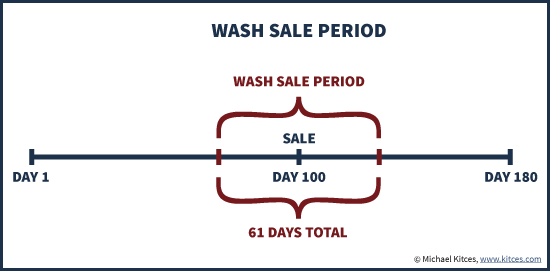Over the last three years, the stock market has provided some valuable investment gains. So far in 2022, the market has given back some of those gains — and as a result, we have an opportunity to capture some investment losses. One of the nice aspects of the tax code is that if an investment is trading at a loss, you can sell the holding and reduce your taxable income.
We recognize that an investor may have seller’s remorse in a down market, but capturing losses to offset current income taxes or future gains is a prudent portfolio management strategy. It is important to note that when you sell a holding for a loss, you do not want to replace that holding with a “substantially identical” investment either 30 days before or 30 days after the sale date, within the timeframe pictured below. Doing so would be a violation of the wash-sale rule.

What is the wash-sale rule?
When you sell an investment that has a loss in a taxable account, you may be eligible for a tax benefit. The wash-sale rule prevents investors from selling at a loss, then buying back the “substantially identical” investment within a 61-day window and being able to claim the tax benefit. This rule applies to stocks, bonds, mutual funds, exchange traded funds (ETFs) and options.
The wash-sale rule states that the tax loss will be disallowed if you buy the same security or “substantially identical” security within 30 days before or after the date you sold the investment for a loss. This includes selling a holding for a loss in a taxable account and then buying it back in a tax-advantaged account.
How can you avoid the wash-sale rule?
ETFs or mutual funds can be helpful in avoiding the wash-sale rule, especially if you are selling an individual stock for a loss. Swapping one ETF for another — or one mutual fund for another — can be tricky because of the “substantially identical” security rule. There are no clear guidelines on what constitutes a “substantially identical” security. If you sell one individual stock and then purchase another security, avoiding the wash-sale rule is much more straightforward. The IRS determines if your transactions violate the rule. If that does happen, you may end up paying more taxes than you anticipated.
You can avoid the wash-sale rule typically in the following ways:
• Avoid buying the same or similar investment 30 days before and after the sale.
• Invest in a materially different investment than the one you sold.
• Have a long-term investment plan during market downturns to help you make the best investing decisions, and don’t sell into a panic and then repurchase.
Remember, you cannot sell an investment for a loss in one account and buy it back in another account, such as in an IRA or spouse’s account. This would disallow the loss to be used since the accounts are under the same ownership. As always, we recommend that you consult with a CPA if you have questions.
What is the penalty?
If the IRS determines that you have violated the wash-sale rule, you cannot use the loss on the sale to offset gains or reduce taxable income. The loss is then added to the cost basis of the new investment. The holding period is added to the holding period of the new investment. There may be a long-term benefit to the higher cost basis to reduce future taxes, and the holding period may help you qualify for long-term capital gains tax rather than short-term capital gains tax. In the short run, however, you are not able to use the loss that you were hoping to have when the investment was sold.
So, what can we learn from all this? While no one wants to see their portfolio value decrease, rebalancing the portfolio (as we did recently) may create some tax losses that can be used to help offset future gains or current income. Tax loss harvesting is an important investment principle and one that we have written about in detail. When one sells a holding for a loss in a taxable account, a “substantially identical” holding cannot be purchased 30 days before or after the sale to avoid the wash-sale rule. It is important to consult your CPA with any questions on the wash-sale rule.
Market volatility can be unsettling, but for long-term investors, it is not unusual. It is likely that the recent market drop could be a mere blip in the long-term investment plan. We are not going to try to time the market; what really matters is time in the market, not out of the market. That means staying the course and continuing to invest, even when the markets dip.
We continue to adhere to the tried-and-true disciplines of diversification, periodic rebalancing and looking forward, while not making investment decisions based on where we have been. It is important to focus on the long-term goal, not on one specific data point or indicator. In markets and moments like these, it is essential to stick to the financial plan. Remember, first and foremost, that panic is not an investing strategy. Neither are “get in” or “get out” — those are just gambling on moments in time. Investing is about following a disciplined process over time.
At the end of the day, investors will be well-served to remove emotion from their investment decisions and remember that over longer time horizons, markets tend to rise. Market corrections are normal, as almost nothing goes up in a straight line. Making market decisions based on what might happen may be detrimental to long-term performance. The key is to stay invested and stick with the financial plan. Markets go up and down over time, and downturns present opportunities to purchase stocks at a lower value.
It all starts with a solid financial plan for the long run that understands the level of risk that is acceptable for each client. Regarding investments, we believe in diversification and having different asset classes that allow you to stay invested. The best option is to stick with a broadly diversified portfolio that can help you to achieve your own specific financial goals — regardless of market volatility. Long-term fundamentals are what matter.
Sources: Fidelity, Forbes, Kitces
This material contains an assessment of the market and economic environment at a specific point in time and is not intended to be a forecast of future events, or a guarantee of future results. Forward-looking statements are subject to certain risks and uncertainties. Actual results, performance, or achievements may differ materially from those expressed or implied. Information is based on data gathered from what we believe are reliable sources.
Using diversification as part of your investment strategy neither assures nor guarantees better performance and cannot protect against loss of principal due to changing market conditions.
Past performance is not a guarantee of future results.
The opinions expressed in this commentary are those of the author and may not necessarily reflect those held by Kestra Investment Services, LLC or Kestra Advisory Services, LLC. This is for general information only and is not intended to provide specific investment advice or recommendations for any individual. It is suggested that you consult your financial professional, attorney, or tax advisor with regard to your individual situation.
Securities offered through Kestra Investment Services, LLC (Kestra IS), member FINRA/SIPC. Investment Advisory Services offered through Kestra Advisory Services, LLC (Kestra AS) an affiliate of Kestra IS. CD Wealth Management and Bluespring Wealth Partners LLC* are affiliates of Kestra IS and Kestra AS. Investor Disclosures: https://bit.ly/KF-Disclosures
*Bluespring Wealth Partners, LLC acquires and supports high quality investment adviser and wealth management companies throughout the United States.






